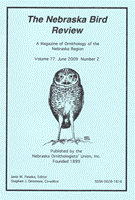Nebraska Ornithologists' Union

Nebraska Bird Review
Date of this Version
12-2018
Document Type
Article
Citation
The Nebraska Bird Review Vol. 86 No. 4 (2018), pp 146-167
Abstract
As far as birds go, this was a relatively quiet season, but, as usual, there was much of interest to chew on. Most important in any report are range changes, major changes in expected numbers or early and late dates, all of which relate directly to the status, positive or negative, of a given species.
Waterfowl in general were only average in numbers; new high counts are rare these days compared with numbers 20 or so years ago. Two winter finches, Common Redpoll and Red Crossbill, that normally arrive in late fall, were virtually unreported. Notable range expansions are under way for three forest species: Red-shouldered Hawk, Barred Owl, and Pileated Woodpecker. Concern is being expressed for Tufted Titmouse, as well as Black-billed Magpie. Rarities are of interest to most of us. Topping the list this fall was Nebraska’s second Anna’s Hummingbird, a stunning male. A Gray Flycatcher was the 6th state record. Black-chinned Hummingbirds continue to be conspicuous in the west with 6th and 7th state records. Less dramatic were a Steller’s Jay and a Varied Thrush. State level rarities include a pair of elliptical migrants that are almost non-existent in fall: the first documented fall record of White-rumped Sandpiper and 7th for Hudsonian Godwit. Unexpectedly late were American Redstart (record late by 16 days) and Yellow-throated Warbler, the latter far west in North Platte in Nov! Also out of place by quite a bit was a Red-naped Sapsucker seen by many NOU members in Brown. A group of wood-warblers appeared in robust numbers, notably the 45 Canada Warblers and 70 Magnolia Warblers, but also 30 Blackburnian Warblers and 42 Black-throated Green Warblers. Record high fall counts were set by Chimney Swift, Caspian Tern, Green Heron, Mississippi Kite, Broad-winged Hawk (12,000!), Least Flycatcher, Gray Catbird, Brown Thrasher, Black-throated Green Warbler (6!), and Indigo Bunting. There were numerous second- and third-highest fall counts as well. Late dates included a dependent fledgling Northern Cardinal in Dixon County 31 Oct and record late fall dates for Willow Flycatcher and Louisiana Waterthrush. Second- and third-latest dates were established for Snowy Egret and Blue Grosbeak. A Lapland Longspur was second-earliest. All this and more below!
Included in
Ornithology Commons, Population Biology Commons, Poultry or Avian Science Commons, Zoology Commons


Comments
Published by the Nebraska Ornithologists’ Union, Inc.